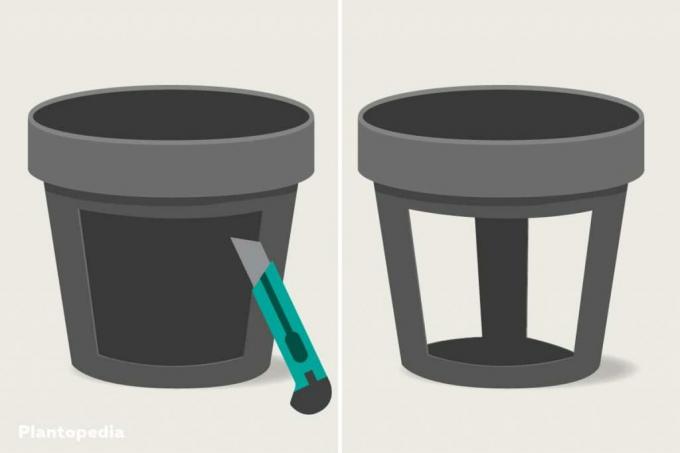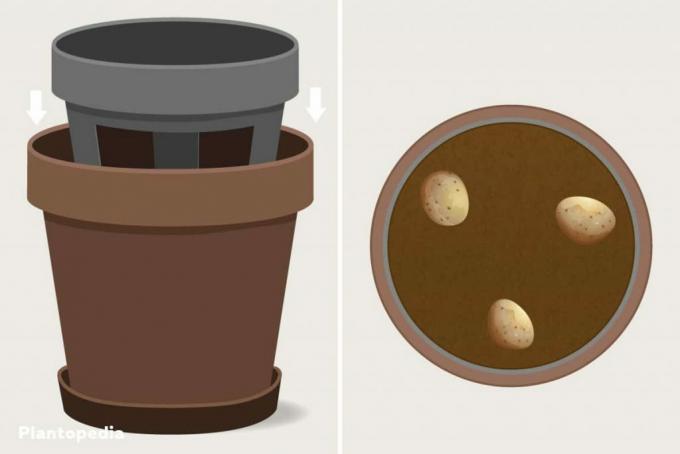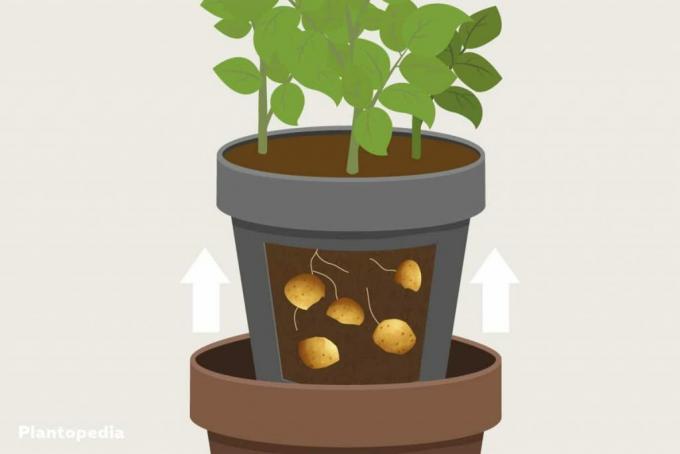
table of contents
- Time to plant
- The piling up
- Growing potatoes
- Pre-germinate potatoes
- Suitable varieties
- Build planters
- Maintain and fertilize
- Harvest potatoes
- Warehousing
- frequently asked Questions
Home and garden owners can easily plant potatoes (Solanum tuberosum) in the garden themselves. Sowing is possible from April. Growing potatoes in pots is popular. Here are instructions for easy harvesting.
In a nutshell
- pre-germinating the plants accelerates growth and maintains health
- two plastic pots are ideal for building a special potato pot
- Windows in the inner pot make it easier to harvest the tubers
- Regular watering and fertilizing is required for the potato to thrive
Time to plant
Potato plants should only be grown when the soil temperature has reached at least seven degrees Celsius. Depending on the type of potato plant, you can plant it in early or late spring.
Note: Potato plants require different nutrients. Consequently, you should optimize the soil with fertilizer in autumn. In addition, an organic fertilizer has a positive effect on the growth of the potato plants in spring.
For a particularly early harvest, it is worth driving the individual potato plants forward at the end of February / beginning of March. This has three advantages:
- earlier harvest
- less prone to disease
- higher yield

The piling up
As soon as the first shoots of the potato plants are 20 centimeters high, piling the potatoes with potting soil is recommended. The tubers do not grow out of the ground and remain edible. In addition, the plants can draw more nutrients from the larger surface and thus grow faster.
Growing potatoes
So with Growing the potato everything goes according to plan, there are detailed instructions. This increases the chance of an easy harvest. With the construction of a special pot, you can grow potatoes yourself on the balcony or in the apartment.
Pre-germinate potatoes
When planting Solanum tuberosum, specimens with eyes are recommended. The shoots appear on the eyes of the potato at a later point in time. Pre-germination is preferable before planting out. Possibly. this allows the harvest to be shifted forward as the plants grow faster.

Tip: Put the potato tubers in dark and cool rooms for several weeks. The Solanum tuberosum drives out over time. You can easily see this. You can then plant the specimens perfectly.
Suitable varieties
However, no specific varieties of potato are required for growing in pots. Basically, you can grow any strain you like. There is an exemplary list here:
- Annabelle
- Charlotte
- Princess
- Stella
- Agria
- Secura
- Bamberg croissant
- Vitelotte
Build planters
With the right materials and tips for the process, you will succeed in growing potatoes in a pot.
The utensils
First of all, you need the appropriate utensils. In addition to the potato, soil and fertilizer, only two plastic pots are required. These should have a capacity between 10 and 20 liters.

Cut the pot to size
The next step is to prepare the future home of the potato. To do this, cut out three large windows on the sides. The bridge between the individual windows should not be too thin so that the pot remains stable in the future. The prepared planter is then placed in a complete flower pot.
Planting
Now plant the vegetables. Green or sprouted specimens are ideal for this. Alternatively, seed potatoes from the garden market are an alternative.
Tip: If you can no longer use green but also speared specimens in the kitchen, you should continue to use them to grow the potato in the pot.

Maintain and fertilize
Regular watering is recommended so that the potato harvest is worthwhile. In addition, fertilizer and compost can improve the growth of vegetables.
Harvest potatoes
The perfect harvest time depends on the type of potato. Basically there are early, medium and late varieties of potatoes. As soon as the foliage dries up and wilts, the tubers are ripe. From now on you should no longer soak the plants with water, otherwise the tubers will rot.
Tip: Move the potato plants to a new location that is protected from rain. After loosening the soil, you can pick the tubers according to your needs.

When the potatoes in the pot are ripe, this is the start or harvest time. You can harvest tasty and tasty potatoes until autumn. To do this, simply take out the inner pot of your own planter. Harvesting is now possible with little effort. Finally, you can simply pull out the prepared flower pot with the windows. You can harvest the potato tubers through the windows without digging up the plants and tubers. Then simply put the planter back in and wait until the next harvest.
Warehousing
Many people choose to store their potato tubers in the basement. However, the warm temperatures can mean that the shelf life suffers. Preferably the tubers are in the open air. When dry and packed with soil, the tubers will last through the next winter.
frequently asked Questions
Planting the potato plants in the raised bed is not the optimal solution. The potato plant has relatively deep roots, so you won't find all the tubers. The effort is enormous and the benefits are manageable. When harvesting in the planter, you always have an overview.
As soon as the seedlings of the potato plants reach 10 centimeters, they fill up with soil. Repeat this process until several layers of the potato plants have formed. The potting soil must not dry out at any time. A plant fleece offers protection from frosty nights.
The potato plants prefer warm and dry soils to which compost has been added. It is usually worth improving the soil with compost and sand. The sooner you start doing it, the better the soil will be for growing vegetables.

